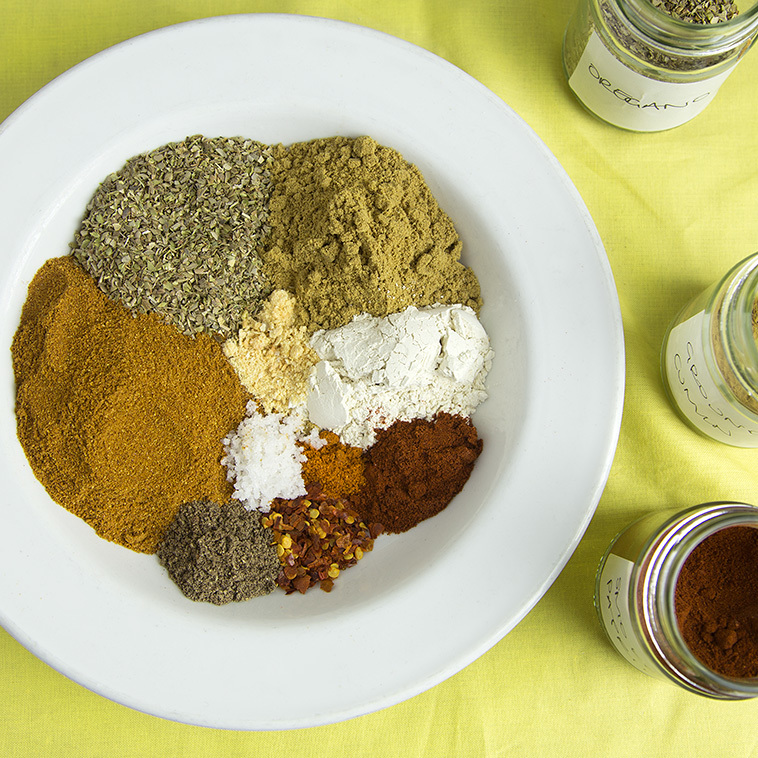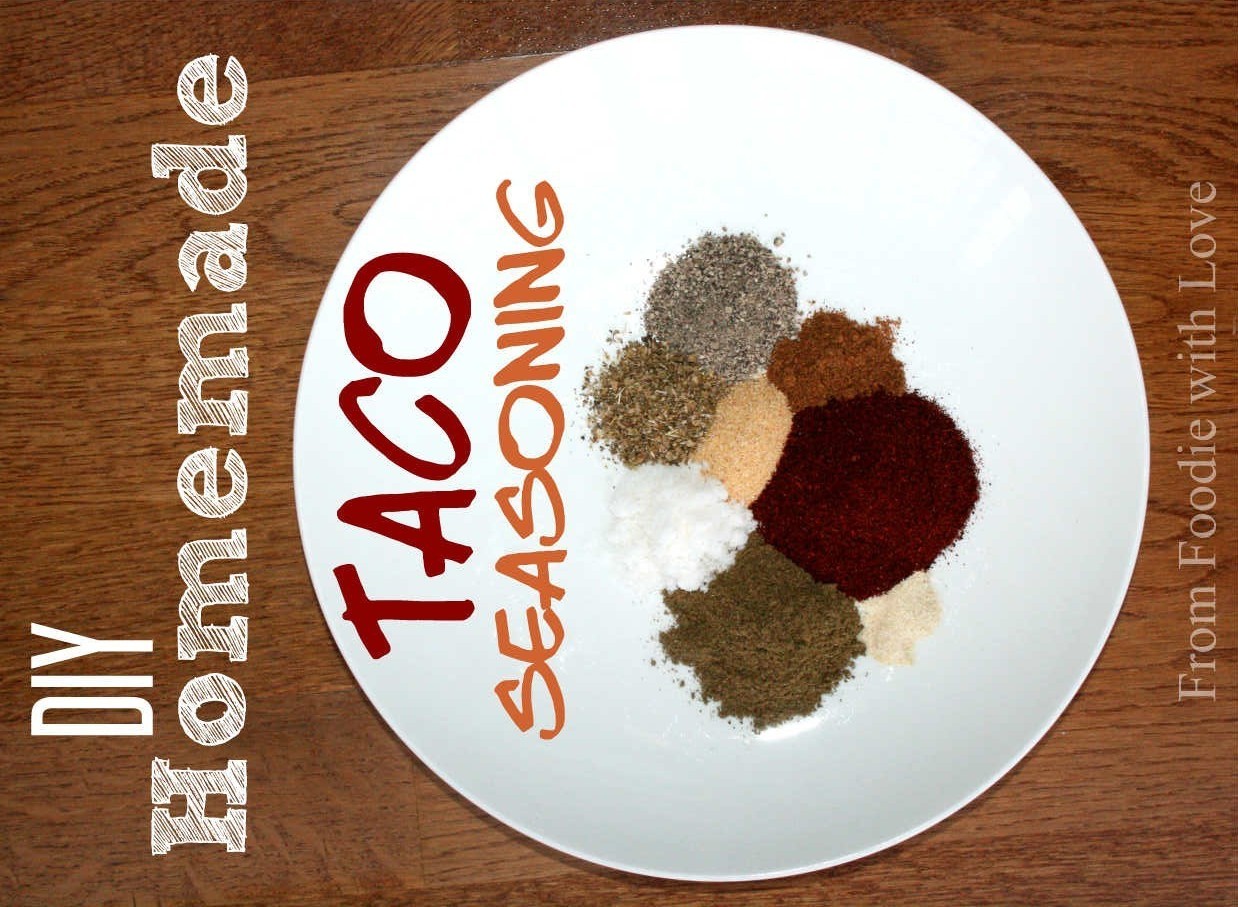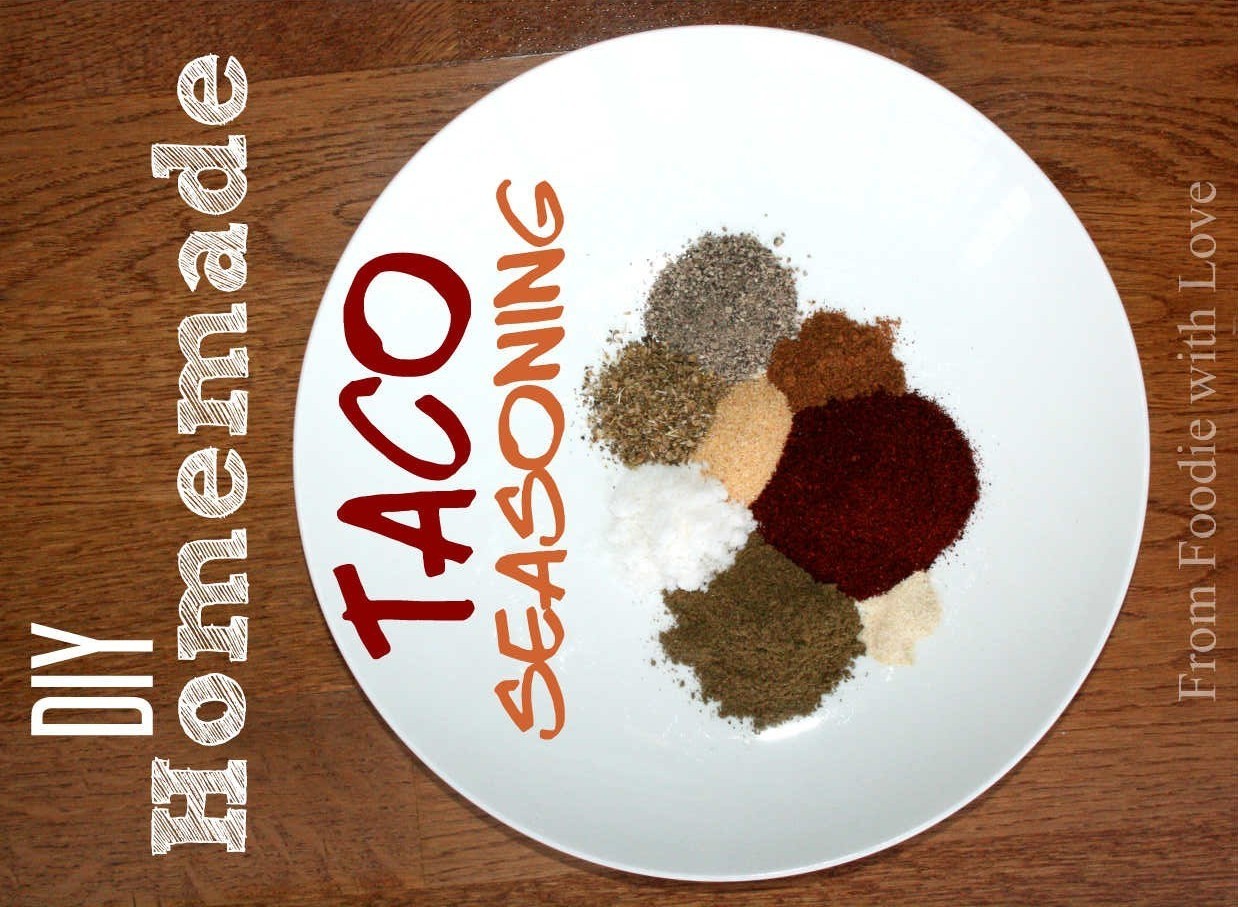DIY taco seasoning opens a world of flavor possibilities, letting you customize your favorite Mexican dish with a blend of spices tailored to your taste. Gone are the days of bland, pre-packaged seasoning packets. With a few simple ingredients and a little experimentation, you can create a symphony of aromas and flavors that will transform your tacos into a culinary masterpiece.
The beauty of homemade taco seasoning lies in its versatility. You can adjust the spice level, add a touch of smokiness, or even incorporate citrus notes to create unique flavor profiles. The possibilities are truly endless, allowing you to explore different culinary dimensions with each batch.
Basic Recipe Variations: Diy Taco Seasoning

A simple homemade taco seasoning recipe is a fantastic starting point for customizing your taco flavors. This basic recipe serves as a foundation for experimenting with various flavor profiles.
Ingredients and Their Roles
The basic recipe typically includes a combination of spices that provide a depth of flavor. Here’s a breakdown of the essential ingredients and their roles:
- Chili Powder: This is the foundation of the seasoning, providing a base of heat and flavor.
- Cumin: Adds a warm, earthy flavor that complements the chili powder.
- Paprika: Adds a mild sweetness and a touch of color.
- Garlic Powder: Enhances the savory notes and adds a subtle aroma.
- Onion Powder: Similar to garlic powder, it contributes savory flavors and a distinct aroma.
- Salt: Balances the flavors and enhances the overall taste.
- Black Pepper: Provides a subtle spiciness and adds complexity to the seasoning.
- Oregano: Adds a slightly herbal and slightly bitter note that rounds out the flavor profile.
Spicy Taco Seasoning
To create a spicy taco seasoning, you can increase the amount of chili powder and add cayenne pepper for an extra kick. For a smoky flavor, you can add smoked paprika or chipotle powder.
Smoky Taco Seasoning
For a smoky flavor, you can add smoked paprika or chipotle powder. Smoked paprika adds a mild smoky flavor, while chipotle powder provides a more intense smoky heat.
Citrusy Taco Seasoning
For a citrusy twist, you can add a pinch of dried orange peel or a teaspoon of lime juice powder. These ingredients will brighten up the flavor profile and add a refreshing element.
Spice Blends & Substitutions
Creating your own taco seasoning allows for a great deal of customization. You can tailor the blend to your preferences by using different spice blends and substituting ingredients.
Common Spice Blends
Spice blends are a great way to add depth and complexity to your taco seasoning. Here are some common blends used in taco seasoning:
- Chili powder: A staple in taco seasoning, chili powder is a blend of spices that includes cumin, paprika, oregano, and cayenne pepper. The specific blend of spices can vary, but chili powder typically provides a smoky, earthy, and slightly spicy flavor.
- Taco seasoning: This blend is typically a pre-made mix of spices, including chili powder, cumin, garlic powder, onion powder, and other spices. Taco seasoning provides a more intense flavor than chili powder, with a balance of savory, smoky, and slightly spicy notes.
- Adobo seasoning: This blend is typically used in Mexican and Southwestern dishes. It is made from a combination of spices including cumin, oregano, garlic powder, onion powder, and paprika. Adobo seasoning is known for its savory and smoky flavor.
- Chipotle powder: This is a smoky and spicy blend of spices made from dried and smoked jalapeños. It provides a distinct smoky flavor with a moderate heat.
Ingredient Substitutions
Many ingredients can be substituted in a taco seasoning recipe. The specific substitution will depend on the flavor profile you are looking for. Here are some common substitutions:
- Cumin: Cumin is a key ingredient in taco seasoning. It provides a warm, earthy flavor. If you don’t have cumin, you can substitute it with coriander, which has a similar flavor profile.
- Paprika: Paprika adds a sweet and smoky flavor to taco seasoning. You can substitute paprika with smoked paprika for a more intense smoky flavor.
- Oregano: Oregano adds a slightly bitter and earthy flavor to taco seasoning. You can substitute oregano with marjoram, which has a similar flavor profile.
- Cayenne pepper: Cayenne pepper provides heat to taco seasoning. You can substitute cayenne pepper with other chili peppers, such as ancho chili powder or chipotle powder, to adjust the level of heat.
Flavor Profiles of Spice Blends
The flavor profile of different spice blends will vary depending on the specific ingredients used. Here is a breakdown of the flavor profiles of some common spice blends:
- Chili powder: A classic blend of spices that provides a smoky, earthy, and slightly spicy flavor.
- Taco seasoning: A more intense blend of spices with a balance of savory, smoky, and slightly spicy notes.
- Adobo seasoning: A blend of spices that is known for its savory and smoky flavor.
- Chipotle powder: A smoky and spicy blend of spices that provides a distinct smoky flavor with a moderate heat.
Flavor Profiles
Taco seasoning can be customized to create a variety of flavor profiles, from mild and traditional to bold and unique. The spice blend you choose will determine the overall taste of your tacos.
Spice Blends for Different Flavor Profiles
The following table shows different flavor profiles and their corresponding spice blends:
| Flavor Profile | Spice Blend |
|---|---|
| Mild | Chili powder, cumin, oregano, garlic powder, onion powder, salt, pepper |
| Spicy | Chili powder, cumin, oregano, garlic powder, onion powder, cayenne pepper, paprika, chipotle powder, salt, pepper |
| Smoky | Chili powder, cumin, oregano, garlic powder, onion powder, smoked paprika, chipotle powder, salt, pepper |
| Citrusy | Chili powder, cumin, oregano, garlic powder, onion powder, lime juice powder, salt, pepper |
| Sweet | Chili powder, cumin, oregano, garlic powder, onion powder, brown sugar, salt, pepper |
Spice Wheel for Taco Seasoning
The spice wheel is a visual representation of different spices and their flavor profiles. It can be used to understand how different spices interact with each other and to create unique flavor combinations.
The spice wheel is a circular diagram that organizes spices by their flavor characteristics. It can be divided into sections based on flavor categories, such as sweet, savory, spicy, and sour.
The spice wheel can be used to create custom taco seasoning blends by selecting spices from different sections of the wheel. For example, you could create a spicy and smoky taco seasoning by combining spices from the “spicy” and “smoky” sections of the wheel.
Choosing Spices Based on Desired Flavor
The following flowchart can be used to choose spices for your taco seasoning based on the desired flavor profile:
Start
* What is your desired flavor profile?
* Mild: Use a base of chili powder, cumin, oregano, garlic powder, onion powder, salt, and pepper.
* Spicy: Add cayenne pepper, paprika, or chipotle powder to the mild blend.
* Smoky: Add smoked paprika or chipotle powder to the mild blend.
* Citrusy: Add lime juice powder to the mild blend.
* Sweet: Add brown sugar to the mild blend.
* Do you want to add any additional flavors?
* Yes: Choose spices from the spice wheel that complement your desired flavor profile.
* No: Proceed to the next step.
* Mix the spices together and adjust the amounts to your liking.
* Enjoy your custom taco seasoning!
End
Storage & Shelf Life

Homemade taco seasoning, like many spice blends, is best stored properly to maintain its flavor and freshness. This section will cover the ideal storage methods and factors that influence shelf life, along with tips for maximizing the seasoning’s freshness.
Storage Methods
Storing your homemade taco seasoning correctly is crucial for preserving its flavor and aroma. Here are the recommended methods:
- Airtight Container: Store the seasoning in an airtight container, such as a glass jar or a resealable plastic bag, to prevent moisture and air from affecting its quality.
- Cool, Dark Place: Choose a cool, dark place to store the seasoning, such as a pantry or cupboard. Avoid storing it near heat sources or direct sunlight, which can degrade the spices.
- Refrigeration: For extended storage, consider storing the seasoning in the refrigerator. This will further slow down the oxidation process and help maintain its freshness.
Factors Influencing Shelf Life
The shelf life of homemade taco seasoning is influenced by several factors:
- Spice Quality: Using high-quality, fresh spices will result in a longer shelf life for your seasoning.
- Moisture Content: Excess moisture can promote mold growth and spoil the seasoning. Ensure the spices are dry before blending and store them in an airtight container.
- Storage Conditions: Proper storage, as mentioned earlier, is essential for maintaining the seasoning’s freshness. Avoid storing it in humid or warm environments.
- Exposure to Air: Exposure to air can cause the spices to oxidize and lose their flavor. Storing the seasoning in an airtight container helps prevent this.
Maximizing Freshness
To maximize the freshness of your homemade taco seasoning, follow these tips:
- Use Fresh Spices: Start with fresh, high-quality spices for the best flavor and longer shelf life.
- Store Properly: Use an airtight container and store the seasoning in a cool, dark place, or even in the refrigerator for extended storage.
- Label with Date: Label the container with the date you made the seasoning to track its freshness and use it within the recommended shelf life.
- Check for Changes: Periodically check the seasoning for any signs of moisture, clumping, or changes in aroma. If you notice any of these, it may be time to discard the seasoning.
Applications of Taco Seasoning
The versatility of homemade taco seasoning extends far beyond its traditional use in tacos. Its bold, flavorful blend of spices can elevate a wide array of dishes, adding depth and complexity to your culinary creations.
Beyond Tacos: Expanding the Flavor Horizons
Taco seasoning’s unique blend of spices makes it a versatile ingredient for various dishes.
- Spice up your Mains: Use it to season ground meat for chili, enchiladas, burritos, and even meatloaf.
- Elevate your Vegetables: Add a kick to roasted vegetables, stir-fries, and even baked potatoes.
- Enhance your Soups and Stews: Infuse a vibrant flavor into soups like chili, vegetable stew, or even lentil soup.
- Add Depth to Dips and Spreads: Incorporate it into dips like guacamole, salsa, or even bean dips for a burst of flavor.
Taco Seasoning as a Base for Other Dishes
The versatility of taco seasoning extends beyond individual ingredients. You can use it as a base for creating entirely new dishes, infusing them with a signature Mexican-inspired flavor.
- Taco Seasoning Chili: This is a classic application, with the seasoning adding a complex depth of flavor to the chili. Combine ground beef, diced tomatoes, kidney beans, and your homemade taco seasoning for a comforting and flavorful chili.
- Taco Seasoning Baked Chicken: Elevate a simple chicken dish with the vibrant flavors of taco seasoning. Combine chicken breasts with taco seasoning, onions, and peppers, and bake until tender and flavorful.
- Taco Seasoning Quesadillas: A simple yet satisfying dish, taco seasoning adds a punch of flavor to quesadillas. Spread a layer of taco seasoning on tortillas, add cheese, and cook until the cheese melts and the tortilla becomes crispy.
Applications of Taco Seasoning Across Cuisines
Taco seasoning’s versatility transcends borders, finding its way into diverse cuisines, adding a unique twist to traditional dishes.
| Cuisine | Application | Example |
|---|---|---|
| Mexican | Tacos, burritos, enchiladas, chili | Classic beef tacos with homemade taco seasoning, loaded with cheese and toppings |
| American | Meatloaf, chili, baked potatoes | Spicy meatloaf with taco seasoning, served with mashed potatoes and gravy |
| Asian | Stir-fries, rice dishes | Chicken stir-fry with taco seasoning, vegetables, and rice noodles |
| Indian | Curries, stews | Chicken curry with taco seasoning, onions, tomatoes, and coconut milk |
Tips for Experimentation
The beauty of DIY taco seasoning lies in its flexibility. You can easily adjust the spice level, experiment with different flavor combinations, and tailor it to your specific preferences. This section provides tips and guidance on how to enhance your taco seasoning game.
Adjusting Spice Level
The spice level of your taco seasoning can be easily adjusted by modifying the amount of chili powder and other hot spices.
- For a milder seasoning, reduce the amount of chili powder and cayenne pepper.
- To increase the heat, add more chili powder, cayenne pepper, or other hot spices like chipotle powder or smoked paprika.
- Experiment with different types of chili powder, such as ancho chili powder, guajillo chili powder, or New Mexico chili powder, for varying levels of heat and flavor.
Experimenting with Flavor Combinations
The possibilities for flavor combinations are endless when creating your own taco seasoning.
- Smoky Flavor: Add smoked paprika, chipotle powder, or a pinch of liquid smoke for a smoky dimension.
- Citrusy Flavor: Incorporate a touch of lime zest or orange zest for a refreshing citrusy twist.
- Earthy Flavor: Add cumin, coriander, or oregano for a more earthy flavor profile.
- Sweet and Spicy: Balance the heat with a touch of sweetness by adding a small amount of brown sugar or honey.
The Role of Herbs
Herbs play a crucial role in enhancing the flavor of your taco seasoning.
- Cumin: Adds a warm, earthy, and slightly bitter flavor.
- Oregano: Contributes a slightly bitter, earthy, and slightly sweet flavor.
- Garlic Powder: Provides a savory and pungent flavor.
- Onion Powder: Adds a sweet, savory, and slightly pungent flavor.
Health Considerations
Homemade taco seasoning offers a healthier alternative to commercially prepared mixes, allowing you to control the ingredients and adjust the flavor profile to suit your dietary needs.
Nutritional Benefits of Homemade Taco Seasoning
Homemade taco seasoning can be a healthier option than commercially prepared mixes because it allows you to control the ingredients and reduce the amount of sodium, sugar, and unhealthy fats.
Tips for Creating a Healthier Version of Taco Seasoning, Diy taco seasoning
Here are some tips for creating a healthier version of taco seasoning:
- Reduce Salt: Commercial taco seasoning often contains high amounts of salt. To reduce sodium intake, use less salt in your recipe or choose a salt substitute.
- Use Whole Spices: Whole spices are more flavorful and nutritious than pre-ground spices. They also contain more antioxidants.
- Limit Added Sugar: Many commercially prepared taco seasonings contain added sugar. To avoid unnecessary sugar intake, omit sugar from your recipe or use a natural sweetener like stevia.
- Use Healthy Fats: Instead of using unhealthy fats like lard or vegetable oil, use healthy fats like olive oil or avocado oil.
Potential Allergens and Dietary Restrictions
It is important to be aware of potential allergens and dietary restrictions when making homemade taco seasoning.
- Common Allergens: Some common allergens found in taco seasoning include:
- Soy: Soy is often used as a thickening agent in taco seasoning.
- Gluten: Gluten is a protein found in wheat, barley, and rye. Some taco seasonings may contain gluten.
- Dairy: Some taco seasonings may contain dairy products, such as cheese powder or buttermilk powder.
- Dietary Restrictions: When making taco seasoning, consider dietary restrictions, such as:
- Vegetarianism: Ensure that the ingredients used are vegetarian-friendly.
- Veganism: Ensure that the ingredients used are vegan-friendly.
- Paleo: If following a paleo diet, avoid ingredients like grains and legumes.
Conclusion
Making your own taco seasoning offers numerous advantages, from greater control over ingredients and flavor profiles to the ability to customize your spice blends to your liking. By taking charge of your seasoning, you can avoid unnecessary additives, control the level of sodium, and experiment with unique flavor combinations that cater to your specific preferences.
The Benefits of Homemade Taco Seasoning
The ability to control the ingredients and flavor profiles of your taco seasoning is a significant advantage. This allows you to customize the spice blend to your preferences, including the level of heat, the inclusion of specific herbs and spices, and the overall flavor profile. By making your own taco seasoning, you can avoid additives, control the sodium content, and ensure the quality of the ingredients.
Ending Remarks
So, ditch the store-bought seasoning and embark on a culinary adventure with DIY taco seasoning. You’ll be amazed at the depth of flavor and the satisfaction of crafting your own unique blend. Get ready to spice up your life and impress your taste buds with the magic of homemade taco seasoning.
